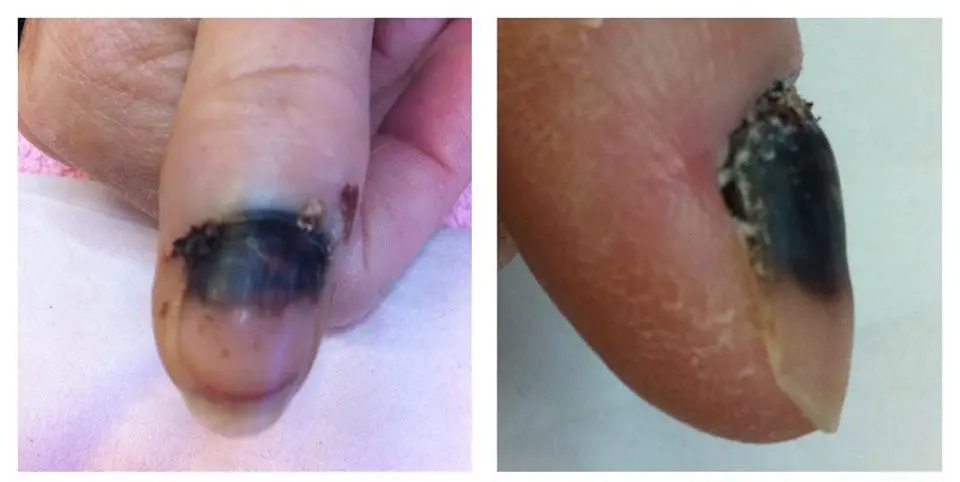Subungual hematoma, also known as a bruised nail, is a medical condition that occurs when blood accumulates underneath the nail. It is usually caused by trauma to the fingertip, such as slamming it in a door, hitting it with a hammer, or even repetitive pressure on the nail. This article explores the definition, causes, symptoms, diagnosis, treatment options, and preventive measures, providing valuable insights into this common nail-related problem.
Definition of Subungual Hematoma
Also known as nail bed hemorrhage or bruised nail is a condition characterized by the accumulation of blood beneath the nail plate. The nail plate acts as a protective cover for the sensitive nail bed, and any injury to the fingertip can cause blood vessels to rupture, leading to blood pooling under the nail.

Causes and Risk Factors of Subungual Hematoma
Subungual hematoma is often a result of sudden trauma to the fingertip. Activities such as jamming a finger, dropping a heavy object on the nail, or repetitive movements that stress the nail can all contribute to this condition. Athletes and individuals who engage in manual labor are particularly susceptible to subungual hematoma due to the nature of their activities.
Symptoms and Signs: Recognizing Discoloration and Pain
The most evident symptom of subungual hematoma is the discoloration of the affected nail. The nail may appear dark purple, black, or reddish-brown due to the trapped blood underneath. Additionally, individuals may experience throbbing pain, swelling around the nail, and tenderness when pressure is applied.
Diagnosing Subungual Hematoma
Identifying Nail Discoloration and Trauma History
In most cases, nail professionals can diagnose subungual hematoma through a physical examination. The characteristic discoloration of the nail and the history of trauma are usually sufficient for diagnosis. However, in some situations where there is uncertainty about the extent of the injury, imaging tests may be recommended.
Utilizing X-rays to Rule Out Underlying Conditions
Imaging tests, such as X-rays, can be utilized to rule out the presence of a fracture or other underlying conditions. X-rays can provide valuable information about the condition of the bone and soft tissues, ensuring that the diagnosis is accurate and any associated injuries are appropriately addressed.
Treatment Options
Promoting Healing and Alleviating Pain
For minor cases of subungual hematoma, home remedies and self-care can often promote healing. This includes elevating the affected finger to reduce swelling, applying ice packs to alleviate pain, and avoiding activities that may worsen the injury. It’s crucial to refrain from attempting to drain the blood from under the nail at home, as this can lead to infection and further complications. Keeping the nail clean & flexible, soap & water with a good quality oil will help alleviate pressure from the nail plate on the nail bed. The dried blood will grow out with the nail plate.
Medical Procedures for Nail Bleeding
In more severe cases, medical intervention may be necessary. A medical professional may create a small hole in the nail to drain the collected blood, relieving pressure and promoting healing. This procedure is known as nail trephination and should only be performed by a qualified healthcare provider. After this procedure its important to keep the nail clean, and free from infection.
Preventive Measures for Nail Bleeding
Tips to Reduce the Risk of Nail Trauma
To reduce the risk of subungual hematoma, individuals can take some precautionary measures. Wearing protective gloves during activities that involve potential finger injuries, such as sports and construction work, can provide a layer of protection. Additionally, taking breaks during repetitive tasks can help prevent trauma to the fingertips.
When to Seek Medical Attention
While many cases of subungual hematoma can be managed at home, it is essential to seek medical attention in certain situations. If the injury is accompanied by severe pain, excessive bleeding, signs of infection, or if there is uncertainty about the extent of the damage, it is best to consult a healthcare professional promptly.
Subungual Hematoma vs. Other Nail Conditions
Differentiating from Fungal Nail Infections and Melanoma
Subungual hematoma can sometimes be mistaken for other nail conditions due to similar symptoms. Understanding the distinguishing features of subungual hematoma can help differentiate it from other problems like fungal nail infections or melanoma.
Considering Medical History and Physical Examination
A healthcare professional can perform a differential diagnosis to accurately identify subungual hematoma and exclude other potential nail disorders. This process involves considering the patient’s medical history, physical examination, and sometimes laboratory tests to reach a precise diagnosis.
The Importance of Timely Intervention
Avoiding Permanent Nail Damage and Deformities
While subungual hematoma may seem like a minor injury, if left untreated, it can lead to complications. Prolonged pressure on the nail bed can cause permanent damage to the nail, leading to deformities or nail loss. In severe cases, the injury might extend to the bone, resulting in fractures.
Long-Term Effects
Timely intervention and appropriate treatment are essential to prevent long-term effects of subungual hematoma. By seeking medical attention promptly and following the recommended treatment plan, individuals can minimize the risk of complications and ensure a quicker recovery.
Safeguarding Nail Health and Well-Being from Nail Bleeding
Subungual hematoma is a common nail-related injury that can occur due to various factors. Understanding the causes, symptoms, and treatment options can help individuals take the necessary precautions and seek timely medical attention when needed. By being proactive in preventing finger injuries and addressing subungual hematoma promptly, individuals can protect their nail health and overall well-being.
FAQs
1. Can I drain the blood from under the nail at home?
Attempting to drain the blood at home can lead to infections and complications. It’s best to seek medical attention for proper treatment.
2. Is nail bleeding hematoma a severe condition?
While it is not typically life-threatening, untreated subungual hematoma can lead to long-term complications and should be addressed promptly.
3. What should I do if my nail doesn’t improve after home care?
If your nail condition worsens or fails to improve after home care, it’s essential to consult a healthcare professional for further evaluation and treatment.
4. Can I still participate in sports or physical activities with a subungual hematoma?
Engaging in physical activities with a nail bleeding can worsen the injury. It’s best to avoid such activities until the nail has healed completely.
5. Are there any preventive measures for subungual hematoma?
Yes, wearing protective gloves during activities that pose a risk of finger injuries and taking breaks during repetitive tasks can help prevent nail bleeding.


